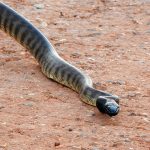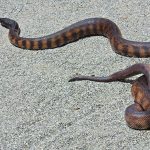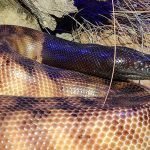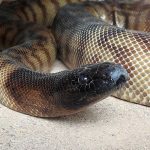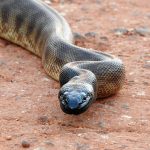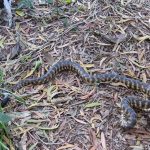BLACK-HEADED PYTHON
Sharon: I have most of my ‘Close Encounters’ with the Black-headed Python in the Cape York region of Northern Queensland in Australia. They can grow quite large and often get quite feisty if you disturb them crossing roads. Their tiger stripes are quite distinctive but it’s their large black shiny head that is a feature.
The Black-headed Python: Guardian of Australia’s Heartland
A Serpent with Presence
The Black-headed Python is a striking inhabitant of Australia’s vast northern and central landscapes. With its coal-black head and boldly banded body, this species is one of the continent’s most recognisable pythons. Let us journey into its world to discover not just its biology, but the role it plays in the intricate web of Australian wildlife.
Range and Habitat
- Geographical Spread:
The Black-headed Python’s domain stretches from the rugged Kimberley region in Western Australia, sweeping across the Northern Territory and Queensland, and reaching the north-eastern edges of South Australia. - Habitats:
- Rocky outcrops: Sheltered crevices provide safe retreats.
- Grasslands and savannas: Rich hunting grounds during the cool dusk.
- Woodlands: Offering both shade and climbing opportunities.
Imagine walking at dusk through a sun-baked savanna, the dry grass whispering in the breeze, as a black-headed sentinel slips silently between rocks—alert, yet calm.
Physical Features
- Size:
Medium-sized, reaching between 1.5 to 2.5 metres in length. - Distinguishing Markings:
- Jet-black head—serves as a dramatic contrast to its lighter, patterned body.
- Body colouring varies, commonly displaying dark brown to black bands on a cream or golden background.
- Robust Build:
Adapted for both climbing and burrowing, with smooth, muscular scales.
Behaviour and Diet
- Nocturnal Hunter:
- Most active at night, when cooler temperatures prevail.
- By day, often found basking on sun-warmed rocks or resting in tree hollows, absorbing the gentle heat.
- Diet:
- Feeds primarily on small to medium-sized mammals, including native rodents and marsupials.
- Will also consume birds and reptiles, such as other snakes or lizards.
- Hunting Method:
- As a constrictor, it suffocates its prey with powerful coils, acting swiftly and efficiently.
The night air is still, scented faintly with eucalyptus and earth. Suddenly, a movement—a rodent scurries, unaware of the silent python poised nearby. In a swift motion, the snake coils, its grip gentle but unyielding, nature’s balance maintained.
Reproduction and Lifecycle
- Breeding Season:
Takes place in spring and early summer, coinciding with rising temperatures and increased food availability. - Egg-laying:
- Females deposit eggs (10–20 per clutch) in warm, protected locations such as termite mounds or hollow logs.
- The mother coils around her eggs, providing protection and subtle warmth by shivering her muscles—a remarkable display of parental care.
- Incubation:
Eggs hatch in about two to three months, with hatchlings emerging ready to fend for themselves.
Conservation and Threats
- Human Impact:
- Habitat loss due to land clearing for agriculture and development diminishes their available territory and safe refuges.
- Current Status:
While not currently listed as threatened, local populations may be at risk where habitat destruction is severe.
The Role of the Black-headed Python
This python is more than a solitary hunter; it is a vital part of its ecosystem, helping to regulate populations of small mammals and birds. Its presence is a sign of a healthy, functioning environment.
Conservation Message
The story of the Black-headed Python is a reminder of the delicate balance within Australia’s wild places. Each species, from the smallest insect to the largest predator, plays a role in maintaining nature’s equilibrium. By preserving habitats and respecting the land, we ensure these ancient guardians continue to glide through the sunlit grasslands and shadowed woodlands for generations to come.
| Feature | Details |
|---|---|
| Scientific Name | Aspidites melanocephalus |
| Length | 1.5–2.5 metres |
| Diet | Mammals, birds, reptiles |
| Habitat | Rocky outcrops, grasslands, woodlands |
| Status | Not threatened, but locally at risk |
To truly appreciate Australia’s wildlife is to understand its interconnectedness—and to cherish the quiet beauty of creatures like the Black-headed Python, guardians of the ancient land beneath our feet.

